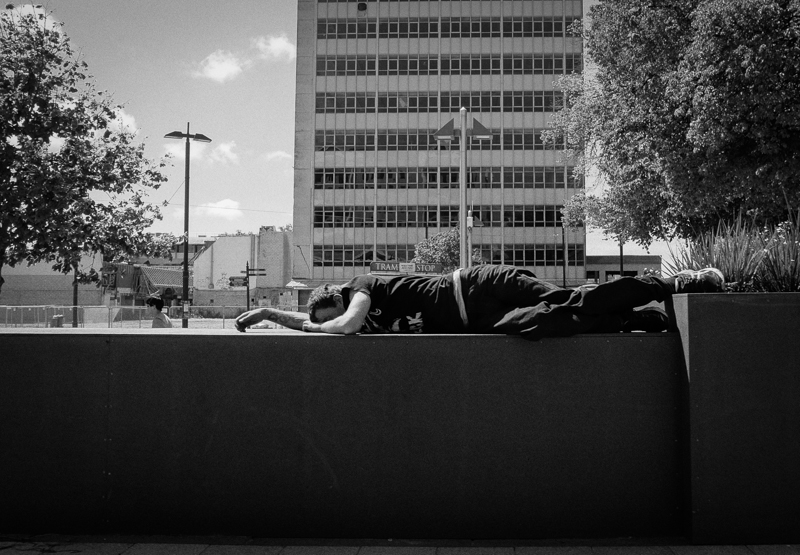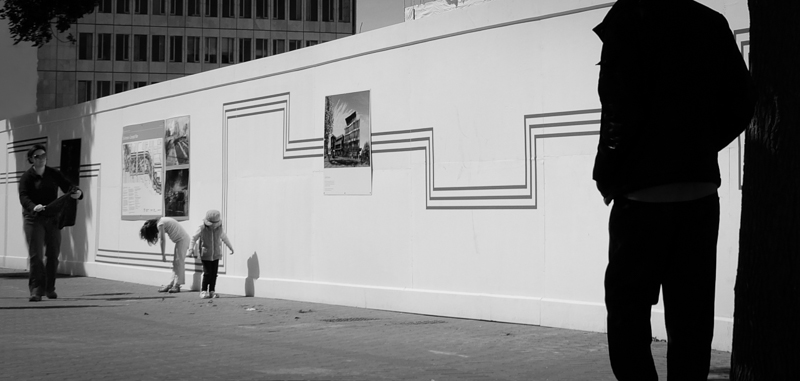On the 3rd of November I attended a street photography workshop run by Fuji and Tony Bridge here in Christchurch. From the range of models on offer for for the day I chose an X-A1. I haven’t used a camera without a viewfinder before and I wanted a bit of a challenge. I spent ten minutes setting it up and working out the controls and went out photographing.
Here are a few thoughts about its use for street photography. This is not strictly a review, just my impressions after two hours of use.
Short version: it’s the street photography camera par excellence.
Long version. A few months ago I borrowed an X-E1 and took it up to Wellington to practise some street work. I was surprised how sensitive people are to a camera held up to my eye. Half a city block away folks would look around and then turn away or depart. Holding the X-A1 at waist level with the rear screen flipped out, you are looking down and you become almost invisible. I could stand within twelve feet of people and not disturb them. Folks were not too bothered even when I held up the camera in the “dirty nappy” position. There must be something going on along the lines of “this chap is a tourist”.
Using the screen like this turned out to be liberating. Yes, a few times it became difficult in bright sunlight, but we are then talking about working a little slower, compared to not working at all if using a DSLR because they are big, noisy and “in your face”.
I have been quietly comparing Fuji cameras to my Canon 5D Mk II.
Background.
I didn’t bother upgrading to the 5D Mk III as I couldn’t see enough improvement in image quality, and couldn’t see that the improved autofocus was worth the cost. I am only interested in making prints (up to 24 inches wide on a Canon IPF 6300). The 5DII gives me enough resolution to do this. With very careful exposure and editing I can take a file shot at 3200 iso and make a 17 wide inch print indistinguishable from one taken at 100 iso. I find 6400 a waste of time.
So how does the X-A1 compare?
Autofocus.
It depends on the lens. Sometimes it’s close, but on the whole I’d give it to the Fuji across the board for speed and accuracy. Perhaps the smaller lenses have less inertia? The only area where I am faster with Canon is selecting the focus point, but that may be experience. And I don’t know if you can have all focus points active with the X-A1, and sometimes that is a real an advantage.
Image quality.
It turns out Lightroom 4 opens the X-E1 raw files but not those for the X-A1. As I haven’t yet upgraded to Lightroom 5.2 I am using the X-A1 jpegs here. I can’t believe I am saying this, but the Fuji jpegs are very good indeed and I would print from them.
Sharpness and detail.
At the street workshop I was using the 16 to 50mm zoom which I hear is not Fuji’s best. Even so, marginal advantage to Fuji. I would happily print to 24 inches wide with this camera. I don’t know how this works but I suspect Fuji lenses are better on the whole than Canon’s. Certainly much better than the 24-105 and no worse than the 70-300L. Also, I photograph hand held a lot , and perhaps the huge mirror slapping up on the Canon is causing some blurring.
Furthermore, the Fuji files uprez nicely. Beautifully detailed prints have been made here to A0 from X-E1 images. I’ve tried several resizing methods with the Canon files and see no difference in print compared to just sending the file straight to the printer. The one exception is printing through Qimage. Clunky to use but sometimes may definitely improve files.
Highlight recovery works better on the X-A1 jpegs than the 5D11 raw files. Less needed and more natural looking. How does that work?
The colour is good. Little or no adjustment needed in Photoshop.
High iso.
Fuji. Quite visibly better in both the X-E1 raw and the X-A1 jpegs (though I would want to do my own processing on the X-A1 raw files to be sure).
Ease of use.
Have to give it to Fuji, it is intuitive to use. I can’t imagine using a Canon without studying the manual and doing some serious practice.
So, am I considering selling my full frame Canon gear after seven years, and going to Fuji with a crop sensor and less megapixels?
Yes.
My mind says this can’t be right, but I’ll trust what my eyes see. I’d give the Fuji equal image quality, better high iso usefulness and a big increase in how the camera fits in my hand. But here’s the deal. And it’s a killer. I got on a plane a few months ago with a Fuji camera and two lenses that covered 28 to 320mm (equivalent FF) – a system giving me enough image quality for my needs – and it all went in a small bag over one shoulder.
If I do any more long haul flights I could carry an X-E2, an X-A1 as a back up, a range of zooms and primes and it would all fit in a small backpack. I’m no longer 18 years old, thank heavens. I want to do photography, not chase detail in every blade of grass. Time to adopt the war cry I pinched from Arthur Meyerson: “let’s go make art!”
No system will do everything, but when I had the X-E1 a few months ago and went out for some landscape photography with friends it was telling that I reached for the Fuji and not the 5DII.
Finally, what about the Sony A7 and A7R? Simple: it’s an unproven system and I’m not using any camera so dependent on adapters. Maybe in a few years when there is a range of native lenses.
Here are a few of my favourite images from Sunday. They aren’t meant to prove anything, just me having fun. One was made holding the X-A1 at waist level using the screen, and two were taken using the camera at right angles and holding down the shutter button as I walked past.



Update
The first photograph above was the winning image on that day. Tony Bridge has made some comments here.
So now I have the pleasure of owning an XF1 which has proved a very useful pocket camera. I have been looking for a small camera that also can produce raw files. This fits the bill exactly. Thank you to Fujifilm NZ.